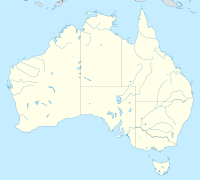Cooper Basin facts for kids
The Cooper Basin is a large area of sedimentary rocks in Australia. It is mostly found in the southwest part of Queensland. It also stretches into the northeast of South Australia. This basin is named after the Cooper Creek, a river that sometimes flows into Lake Eyre. Much of the Cooper Basin is covered by another basin called the Eromanga Basin. The Cooper Basin covers a huge area of about 130,000 square kilometers.
The land above the Cooper Basin is mostly desert. This includes parts of the Simpson Desert, the Channel Country, and the Sturt Stony Desert. People started looking for oil and gas in this area in 1962.
Energy from the Cooper Basin
Oil and Natural Gas
The Cooper Basin is very important for Australia's energy. It holds some of the biggest onshore deposits of petroleum (oil) and natural gas. These valuable resources are found about 1,250 meters (or 4,100 feet) below the ground. They were first discovered in the 1960s.
The first time gas was found in a way that could be sold was in 1963. The basin also has Australia's largest onshore oil field, called the Jackson oil field. This field was found in 1981. Pipelines carry the gas from the Cooper Basin to big cities like Brisbane, Adelaide, and Sydney. So far, about 1,800 wells have been drilled to find oil and gas.
The biggest company producing energy here is Santos Limited. Their main production site is at Moomba, South Australia. From Moomba, oil and gas travel through the Moomba Adelaide Pipeline System. The oil and gas pockets in the Cooper Basin are often small. But they are still very profitable because it doesn't cost too much to drill for them.
There are about 160 gas fields and 75 oil fields working in the basin. These fields have around 630 gas wells and over 340 oil wells that are producing energy. Many smaller companies are also looking for more deposits in the area. Some of these companies include Cooper Energy, Beach Petroleum Limited, Senex Energy, and Strike Energy.
Geothermal Energy
Companies have also explored the Cooper Basin for geothermal energy. This is energy that comes from the heat inside the Earth. They have drilled holes and measured temperatures deep underground. They found very hot granite rocks about 3.5 kilometers (2.2 miles) deep. These rocks can reach temperatures of 240 °C (464 °F).
The Cooper Basin is a great place for a geothermal project. This is because its rocks are some of the hottest in the world at depths where drilling is possible. Also, these hot rocks are far away from volcanoes. During some early tests in 2003, very small ground movements were noticed.
Hidden Impact Crater
The Cooper Basin also hides a secret from long ago. It covers an impact crater that was made about 300 million years ago. A scientist named Tonguç Uysal discovered this crater. The discovery was announced in October 2010.
This crater is at least 80 kilometers (50 miles) wide. This makes it one of the largest of Australia's many known or suspected impact craters.


